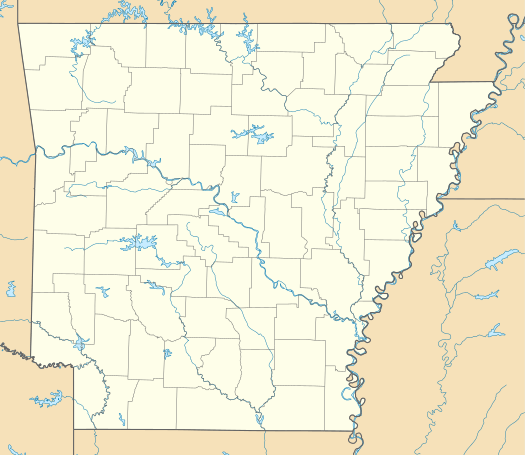Battle of Poison Spring
| ||||||||||||||||||||||||||||||
The Battle of Poison Spring (April 18, 1864) was fought in Ouachita County, Arkansas as part of the Camden Expedition, during the American Civil War. The battle is infamous for the Confederates' slaughter and mutilation of black U.S. soldiers of the 1st Kansas Colored Infantry.[1]
Background
Dwindling supplies for his army at Camden, Arkansas forced Union Army Major-General Frederick Steele to send out a foraging party to gather corn that the Confederates had stored about twenty miles up the Prairie D’ Ane–Camden Road on White Oak Creek. The party loaded the corn into wagons, and on April 18, Colonel James Monroe Williams started his return to Camden. Brigadiers-General John Marmaduke’s and Samuel Maxey’s Confederate forces arrived at Lee Plantation, about fifteen miles from Camden, where they engaged Williams.
Opposing forces
Union
Confederate
Battle
The Confederates eventually attacked Williams in the front and rear, forcing him to retreat north into a marsh where his men regrouped and then fell back to Camden. During the fight, Williams positioned the 1st Kansas Colored Infantry, a regiment made up of mostly ex-slaves, between the wagon train and Confederate lines; these black troops repelled the first two offenses, but ran low on ammunition and were beaten back by the third. The Confederates refused to take the wounded black soldiers as prisoners, and instead brutally killed, scalped, and stripped them. Confederate Colonel Tandy Walker (commanding Choctaw Brigade) reported:
...the train fell into our hands, and soon a portion of his artillery, which my troops found concealed in a thicket near the train. I feared here that the train and its contents would prove a temptation too strong for these hungry, half-clothed Choctaws, but had no trouble in pressing them forward, for there was that in front and to the left more inviting to them than food or clothing—the blood of their despised enemy. They had met and routed the forces of General Thayer, the ravagers of their country, the despoilers of their homes, and the murderers of their women and children.[2]
In all, the 1st Kansas lost nearly half of its numbers. The Union lost 198 wagons and all the corn. Estimated casualties were 301 for Williams and 114 for the Confederates.
Aftermath
A few months after the battle, Washington, Arkansas mayor, editor of the Washington Telegraph, postbellum justice of the Arkansas Supreme Court, and important Confederate propagandist John R. Eakin wrote an editorial approving of the massacre of black U.S. soldiers: "They did right [...W]e cannot treat negroes taken in arms as prisoners of war without a destruction of the social system for which we contend."[1]
The site of the battle, the Poison Spring Battlefield is listed on the National Register of Historic Places and is part of the Camden Expedition Sites National Historic Landmark.
In popular culture
- The battle is mentioned in the 2012 film Lincoln.
See also
References
- 1 2 Loewen, James W.; Sebesta, Edward H. (2010). "The Slave Soldiers". The Confederate and Neo-Confederate Reader. Jackson, Mississippi: University Press of Mississippi. pp. 209–211. ISBN 978-1-60473-218-4. Retrieved March 17, 2016.
- ↑ War of the Rebellion: Official Records of the Union and Confederate Armies, Series I, Volume 34, part 1, page 849.
Further reading
- Battle description in the Arkansas Historical Quarterly, Volume XXVIII (Winter 1959), p. 338
- "Confederates inflict pain at Battle of Poison Spring". History Channel. Archived from the original on March 8, 2010. Retrieved May 9, 2014.
Further reading
- Castel, Albert (1993) [1st pub. 1968]. General Sterling Price and the Civil War in the West (Louisiana pbk. ed.). Baton Rouge; London: Louisiana State University Press. ISBN 0-8071-1854-0. LCCN 68-21804.
External links
- Battle of Poison Spring at the American Battlefield Protection Program
- Battle of Poison Spring at Encyclopedia of Arkansas History & Culture
- Regimental Colors of the 1st Colored Infantry at the Kansas Historical Society
